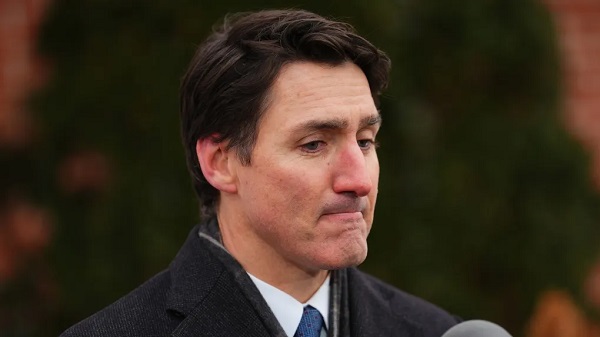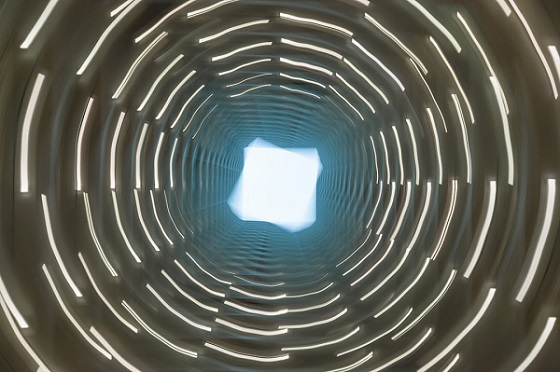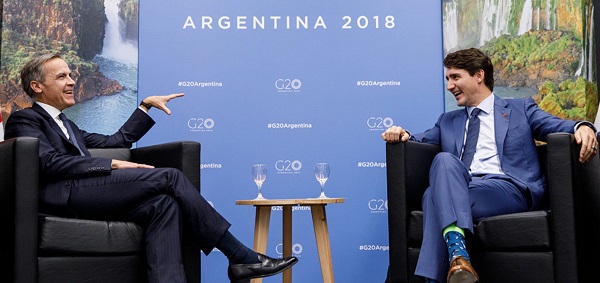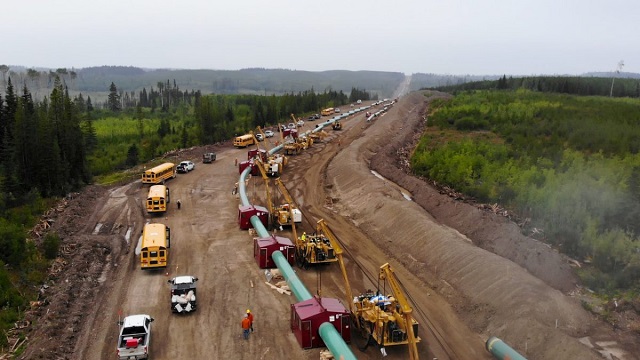National
After a decade spinning in a maelstrom, we’re headed straight into a hurricane.

To choose Trudeau’s successor as the Liberal Party’s new helmsperson, you need only be temporarily resident in Canada and 14 years old, and they don’t even check
Terry Glavin with The Real Story
Après nous, le déluge
It’s over. Well, sort of.
The Trudeau Liberals’ hegemonic hold on Canada’s political, cultural and economic life is now officially and formally winding down. Parliament has been prorogued until March 24, although it isn’t certain that Canada will have a new Parliament with a new prime minister even by June, when Canada is supposed to be hosting the G7, by which time the Liberals are expected to have a new leader too.
Who knows. We’ll get there. Justin Trudeau will be gone, but this is what you should bear in mind as Canada careens and lists and tumbles out of this mess.
The world’s first “postnational state” that Trudeau inaugurated in 2015, with the able assistance of Dominic Barton’s McKinsey & Company and all the resources the Canada-China Business Council threw at the project, was never intended to be some four-year thing to be evaluated by voters in the ordinary course of events.
It was built to be permanent. Its undoing will require one hell of an effort, and in the meantime Donald Trump’s inauguration – a $150 million extravaganza funded by Pfizer, OpenAI, Amazon, Meta and a constellation of cryptocurrency firms – is set for January 20.
That’s just two weeks away, and Trump has pledged to impose what would be a crippling 25 percent tariff on goods from Canada and Mexico “on Day 1” unless measures regarding flows of illegal migrants and drugs are somehow stopped.
We’ll see. The thing is, on Day 1, Canada’s federal government will be locked in the interregnum between the Trudeau epoch and Conservative leader Pierre Poilievre’s new “common sense” order. We’re sitting ducks.
What would a Conservative Great Leap Forward look like?
Poilievre deserves much credit for correctly diagnosing the several possibly fatal wounds the Justin Trudeau decade has inflicted on this country. About that, here’s something I found fascinating over the holiday hiaitus.
It would be worth your time to take in Poilievre’s conversation with Dark Web archdruid Jordan Peterson over the weekend, and then have a listen to the year-end remarks of the lonesome American socialist warlord Bernie Sanders.
Going by my own 90-minute encounter with Peterson a couple of weeks ago I can say that it isn’t easy to keep the conversation going exactly along the lines one might prefer. Not to criticize Peterson’s interviewing style but I can’t fault Poilievre for failing to get into any number of the the existential dysfunctions Canada is enduring.
Even so, Poilievre comes off more like an intelligent and slightly nerdy Canadian version of Bernie Sanders than the doofus Canadian iteration of Donald Trump that the Liberals and New Democrats have so strenously tried and failed to make him out to be.
Fun example: On Saturday, the NDP MP Peter Julian attributed Poilievre’s popularity to a “massive foreign interference strategy. . . the only reason Pierre Poilievre is leader of the Conservative Party right now.” He didn’t say this while drunk in a private conversation among fellow NDPers. Julian said this publicly, on the insufferable Elon Musk’s X, drawing on a thoroughly debunked conspiracy theory from last August.
At least the Conservatives are not crazy people
Today, the Feast of the Epiphany, is the anniversary of the Trumpist insurrection of January 6, 2021, an event that remains an open and profoundly embarrassing wound among Americans. I fully realize that there are some yobbish Putin fanciers at the outer fringes of Canada’s Conservative Party, but give me a break.
Can you imagine Canadian Conservatives storming Parliament Hill, smashing windows and breaking down doors and baying for blood? Of course you can’t. And you certainly can’t imagine Poilievre even coming close to countenancing such conduct, so don’t even try.
I don’t carry any water for Poilievre, but I am persuaded that he’s genuinely and sincerely concerned about the wretched state of affairs to which working-class Canadians have been reduced. Besides, Poilievre isn’t just the best alternative we’ve got. He’s the only alternative. Jagmeet Singh’s New Democrats are a caricature of the party they inherited, so here we are.
My National Post readers and this newsletter’s subscribers will know that I am not bubbling with optimism that Poilievre’s remedies can possibly heal what Canada has sustained. Without getting into all that, I’ve had my say, and while Poilievre’s overall analysis of the Trudeau era’s calamities is grounded in hard facts and driven by empathy, his “Axe the tax, Build the homes, Fix the budget, Stop the crime” remedies are woefully insufficient to the circumstances of the real world.
For starters, the immediate crisis a Poilievre government will face is the major cause of the economic dislocation we’re facing, and he’s been quiet about it: It’s not just that Canada’s housing and jobs economies have no room for roughly three million people in this country who are here on various kinds of “temporary” status. It’s more like 4.9 million people whose visas are going to expire before the end of this year.
No amount of tax-axing is going to deal with this, and you’d need something along the lines of a Mao-era Great Leap Forward to “build the homes” to house them all in residential markets that would be even vaguely affordable for most people. And to do that you’d have to tear down Canada’s cities and build a grim Leninplatz on top of each heap of rubble.
Here’s just one other little thing that could stand in the way of any effective legislative agenda that Poilievre might want to embark upon. Almost all the current occupants of the Upper Chamber are senators appointed by Justin Trudeau. So, that’ll be fun: on top of everything else, the prospect of forcing a constitutional crisis just to get anything done.
Not to be dreary, but about the brokenness, but see Notes on the Coming Disturbances, and a earlier assessment: Nearing Nine Years Since Year Zero, So there’s all that.
It’s not just Canada that’s broken. It’s the Liberal Party.
To build the new postnational state in place of what we’ve been badgered to understand as the genocidal old-stock white supremacist settler-state patriarchy that Trudeau so gallantly set out to save from itself, the Liberal Party had to be refashioned to serve as the conduit to Parliamentary power and privilege. See It’s 2025. Welcome to the Thunderdome.
Bear in mind that Justice Marie-Josée Hogue’s Public Inquiry into Foreign Interference in Federal Electoral Processes and Democratic Institutions is expected to issue its final report before the end of this month. The inquiry’s long-delayed and filibustered timetable had anticipated that Hogue’s proposed structural changes would be in place well before what was presumed to be an October 2025 federal election.
Here’s the thing about that. Never mind that owing to Team Trudeau’s rewriting of the party constitution we still don’t know who elected Trudeau to the leadership of the Liberal Party in the first place, and there’s been no inquiry into the massive infusions of weirdly coordinated Mandarin-bloc donations to Trudeau’s own riding association warchest in the aftermath of his 2015 capture of a Parliamentary majority.
See: Liberals are leaving an ungodly mess for Poilievre’s Conservatives to clean up; New report details just how easily China can mess with Canadian elections. In that piece, and in the Thunderdome newsletter, I refer at length to the findings in this in-depth analysis published by the Canadian International Council: Beyond general elections: How could foreign actors influence the prime ministership?
While all the talking-head punditry and chat-show panelists are preoccupied with speculation about just who might emerge as Justin Trudeau’s successor, here’s just one fact that has gone unnoticed. If you simply happen to be domiciled even temporarily in this country, you only have to be 14 years old to cast your vote for the next leader of the Liberal Party of Canada.
All for now.
Yes, this was a newsletter with no paywall.
To keep this project going, do please take up a paid subscription.
Health
Tens of thousands are dying on waiting lists following decades of media reluctance to debate healthcare

Better thousands of us die prematurely, apparently, than risk a grownup conversation
About the same time as William Watson’s outstanding book Globalization and the Meaning of Canadian Life was being published in the late 1990s, the newspaper I worked for was sending a journalist to Europe to research a series of articles on how health care systems work in some of those countries.
The Rewrite is a reader-supported publication.
To receive new posts and support my work, consider becoming a free or paid subscriber.
I mention Bill’s book, which was runner-up for a public policy Donner Prize, because it exquisitely details many of the things Canadians believe about themselves that simply aren’t true. Which was the same reason why the Calgary Herald sent its health reporter (yes, there used to be such a thing), Robert Walker, to Europe – to expose its readers to the fact that there are more than two health care systems: our “defining” one and America’s, both of which are extremes. To the best of my knowledge, that remains the only time a Canadian news organization has taken on that task.
In every country examined in Walker’s reports, as is the case with almost every country in the world, public and private health care and insurance systems maintained a peaceful coexistence and the public’s needs were being met. Almost 30 years later, that remains the case. Also almost 30 years later, neither Bill’s book nor the Herald’s reporting has had the slightest impact on the prevailing media narrative in Canada. It remains determined to perpetuate the fear that any move to increase the role of private health providers or even allow doctors to work in both systems (as was proposed this week by Alberta Premier Danielle Smith) is the first step on the slippery slope to “American-style” health care. This line has been successfully used for decades – often hyperbolically and occasionally hysterically – by public monopoly advocates for Canada’s increasingly expensive and difficult to access systems. We have known for 40 years that once Baby Boomers like your faithful servant turned bald and grey that the system would be unsustainable. But that single, terrifying “American-style” slur has halted reform at every turn.
The Tyee responded with a “Danielle Smith’s secret plan to Destroy Public Health Care” column while the Globe and Mail’s Gary Mason, a Boomer, challenged my thesis here by suggesting it was time for open minds because “the reality is, the health care system in Canada is a mess.”
It is. And at least some of the blame – a lot, in my view – belongs at the door of Canadian news organizations that for decades have failed to fully inform readers by making them aware that there are a great many alternatives to just “ours” and “US-style.”
I was reminded of this in a recent Postmedia story concerning the perils of private health care provision. Referencing a study on MRIs, the story, right on cue, quotes the part of a study that states “It’s a quiet but rapid march toward U.S.-style health care.”
One would not want to suggest that those clinging to that parochial view should be denied a platform. But at the same time, readers have every right to demand that journalists push back and ask advocates for state monopolies simple questions such as “Why do you say that? Could it not be the first step towards UK-, German-, Dutch-, French-, Portugese- or Swedish-style health care?” and open the debate.
But, as it was 30 years ago and likely ever shall be, there is nothing to suggest that approach even crossed the reporter’s mind. Canadians deserve to be fully informed on major public policy matters and the record shows that when it comes to health care, media have largely failed to do so. Stuck in the fetid trench of an us and them narrative that compares two systems at extreme ends of the spectrum, the public is largely unaware that moderate alternatives exist, ensuring that no meaningful reforms will ever take place and tens of thousands of Canadians will continue to die on waiting lists – a story that continues to be of little interest within the mainstream. Better thousands of us die prematurely, apparently, than risk a grownup conversation that could challenge our national mythology and lead us down the path to “European-style” healthcare.
The Rewrite is a reader-supported publication.
To receive new posts and support my work, consider becoming a free or paid subscriber.
Postmedia’s Brian Lilley has written a defence of the use by journalists of anonymous sources. Lilley’s introduction describes him as coming down on both sides of the issue and that “Using anonymous sources is completely justified, if done right.” Well of course it is, but in my view it’s frequently and increasingly not being done right and its abuse is being exploited by government comms people to control the narrative.
An example of that occurred last week when the Globe and Mail, in a story concerning Prime Minister Mark Carney’s sojourn to the United Arab Emirates, declined to reveal the identity of a source offering very standard information. To wit:
“The (senior government) official, whom The Globe and Mail is not identifying because they were not authorized to speak publicly, said this visit matters because the UAE economy is very much driven by personal relationships – the kind that benefit from face-to-face meetings.”
This story had three bylines – from a senior parliamentary reporter, an institutional investing reporter and an economics reporter. It is inconceivable to me that, between them, they couldn’t find an on the record source who could explain how important it is, culturally, to have face to face meetings, particularly in that part of the world. Doing so would have added some needed thump to a “sources say” story and helped mute criticisms by others in the industry such as John Robson and Holly Doan, the latter stating in a Tweet that “Anon sources are gov’t propagandists.” Others have privately expressed their dismay.
Meanwhile, I expect Lilley’s piece is worth a read and it’s important to hear all sides but as it is behind a paywall I haven’t got to it myself. It’s also worth pointing out that a recent Reuters Institute survey put Lilley in Canada’s top 10 social media influencers and creators.
Sadly, we have more this week on unnecessary online smartassery by journalists.
First up is Global News’s Sean O’Shea who managed to allow himself to look like a member of Carney’s comms team when he Tweeted his disapproval of some fans’ behaviour at the Grey Cup.
Then came The Hill Times’s Stu Benson, who blasted his alarm from a loudspeaker before deleting.
Honestly, folks, to paraphrase grandpa’s advice and as I have to remind myself from time to time, just because something pops into your head doesn’t mean it has to pop onto your social media feed.
Last week’s column for The Hub on how Diversity, Equity and Inclusion initiatives remain alive and enforced in the nation’s newsrooms is available here. And don’t forget to watch out for the Full Press podcast with myself, Harrison Lowman and Tara Henley on Thursday.
(Peter Menzies is a commentator and consultant on media, Macdonald-Laurier Institute Senior Fellow, a past publisher of the Calgary Herald, a former vice chair of the CRTC and a National Newspaper Award winner.)
The Rewrite is a reader-supported publication.
To receive new posts and support my work, consider becoming a free or paid subscriber.
Business
Budget 2025: Ottawa Fakes a Pivot and Still Spends Like Trudeau

It finally happened. Canada received a federal budget earlier this month, after more than a year without one. It’s far from a budget that’s great. It’s far from what many expected and distant from what the country needs. But it still passed.
With the budget vote drama now behind us, there may be space for some general observations beyond the details of the concerning deficits and debt. What kind of budget did Canada get?
Haultain’s Substack is a reader-supported publication.
To receive new posts and support our work, please consider becoming a free or paid subscriber.
Try it out.
For a government that built its political identity on social-program expansion and moralized spending, Budget 2025 arrives wearing borrowed clothing. It speaks in the language of productivity, infrastructure, and capital formation, the diction of grown-up economics, yet keeps the full spending reflex of the Trudeau era. The result feels like a cabinet trying to change its fiscal costume without changing the character inside it. Time will tell, to be fair, but it feels like more rhetoric, and we have seen this same rhetoric before lead to nothing. So, I remain skeptical of what they say and how they say it.
The government insists it has found a new path, one where public investment leads private growth. That sounds bold. However, it is more a rebranding than a reform. It is a shift in vocabulary, not in discipline.
A comparison with past eras makes this clear.
Jean Chrétien and Paul Martin did not flirt with restraint; they executed it. Their budgets were cut deeply, restored credibility, and revived Canada’s fiscal health when it was most needed. The Chrétien years were unsentimental. Political capital was spent so financial capital could return. Ottawa shrank so the country could grow. Budget 2025 tries to invoke their spirit but not their actions. Nothing in this plan resembles the structural surgery of the mid 1990s.
Stephen Harper, by contrast, treated balanced budgets as policy and principle. Even during the global financial crisis, his government used stimulus as a bridge, not a way of life. It cut taxes widely and consistently, limited public service growth, and placed the long-term burden on restraint rather than rhetoric. Budget 2025 nods toward Harper’s focus on productivity and capital assets, yet it rejects the tax relief and spending controls that made his budgets coherent.
Then there is Justin Trudeau, the high tide of redistribution, vacuous identity politics, and deficit-as-virtue posturing. Ottawa expanded into an ideological planner for everything, including housing, climate, childcare, inclusion portfolios, and every new identity category. Much of that ideological scaffolding consisted of mere words, weakening the principle of equality under the law and encouraging the government to referee culture rather than administer policy.
Budget 2025 is the first hint of retreat from that style. The identity program fireworks are dimmer, though they have not disappeared. The social policy boosterism is quieter. Perhaps fiscal gravity has begun to whisper in the prime minister’s ear.
However, one cannot confuse tone for transformation.
Spending is still vast. Deficits grew. The new fiscal anchor, balancing only the operating budget, is weaker than the one it replaced. The budget relies on the hopeful assumption that Ottawa’s capital spending will attract private investment on a scale that economists politely describe as ambitious.
The housing file illustrates the contradiction. The budget announces new funding for the construction of purpose-built rentals and a larger federal role in modular and subsidized housing builds. These are presented as productivity measures, yet they continue the Trudeau-era instinct to centralize housing policy rather than fix the levers that matter. Permitting delays, zoning rigidity, municipal approvals, and labour shortages continue to slow actual construction. Ottawa spends, but the foundations still cure at the same pace.
Defence spending tells the same story. Budget 2025 offers incremental funding and some procurement gestures, but it avoids the core problem: Canada’s procurement system is broken. Delays stretch across decades. Projects become obsolete before contracts are signed. The system cannot buy a ship, an aircraft, or an armoured vehicle without cost overruns and missed timelines. Spending more through this machinery will waste time and money. It adds motion, not capability.
Most importantly, the structural problems remain untouched: no regulatory reform for major projects, no tax competitiveness agenda, no strategy for shrinking a federal bureaucracy that has grown faster than the economy it governs. Ottawa presides over a low-productivity country but insists that a new accounting framework will solve what decades of overregulation and policy clutter have created. More bluster.
To receive new posts and support our work, please consider becoming a free or paid subscriber.
From an Alberta vantage, the pivot is welcome but inadequate. The economy that pays for Confederation, energy, mining, agriculture, and transportation receives more rhetorical respect in Budget 2025, yet the same regulatory thicket that blocks pipelines and mines remains intact. The government praises capital formation but still undermines the key sectors that generate it.
Budget 2025 tries to walk like Chrétien and talk like Harper while spending like Trudeau. That is not a transformation; it is a costume change. The country needed a budget that prioritized growth rooted in tangible assets and real productivity. What it got instead is a rhetorical turn without the courage to cut, streamline, or reform.
Canada does not require a new budgeting vocabulary. It requires a government willing to govern in the best interest of the country.
Haultain’s Substack is a reader-supported publication.
Help us bring you more quality research and commentary.
-

 Health19 hours ago
Health19 hours agoTens of thousands are dying on waiting lists following decades of media reluctance to debate healthcare
-

 Business2 days ago
Business2 days agoI Was Hired To Root Out Bias At NIH. The Nation’s Health Research Agency Is Still Sick
-

 Carbon Tax22 hours ago
Carbon Tax22 hours agoCarney fails to undo Trudeau’s devastating energy policies
-

 Opinion14 hours ago
Opinion14 hours agoLandmark 2025 Study Says Near-Death Experiences Can’t Be Explained Away
-

 Business19 hours ago
Business19 hours agoBudget 2025: Ottawa Fakes a Pivot and Still Spends Like Trudeau
-

 International1 day ago
International1 day agoCanada’s lost decade in foreign policy
-

 armed forces1 day ago
armed forces1 day agoCanada At Risk Of Losing Control Of Its Northern Territories
-

 Business2 days ago
Business2 days agoLarge-scale energy investments remain a pipe dream










